The US dollar strengthened across markets as optimism about a potential second Trump presidency increased expectations for tax cuts, deregulation, and higher tariffs on China and the EU.
This drove the DXY to a four-month high and pressured major currencies like the euro, yen, and pound, with EUR/USD at 1.0630 and GBP/USD near 1.2820. Precious metals were also affected; gold fell to $2,600 per ounce, and silver dropped to $30.20 as investors moved to riskier assets. Key support and resistance levels remain in focus as markets await US inflation data and Fed signals.
| Time | Cur. | Event | Forecast | Previous |
| 7:00 | EUR | German CPI (YoY) (Oct) | 2.00% | 1.60% |
| 7:00 | EUR | German CPI (MoM) (Oct) | 0.40% | 0.00% |
| 9:00 | GBP | BoE MPC Member Pill Speaks | | |
| 10:00 | EUR | ZEW Economic Sentiment (Nov) | 20.5 | 20.1 |
| 15:00 | USD | Fed Waller Speaks | | |
| 19:00 | USD | FOMC Member Kashkari Speaks | | |
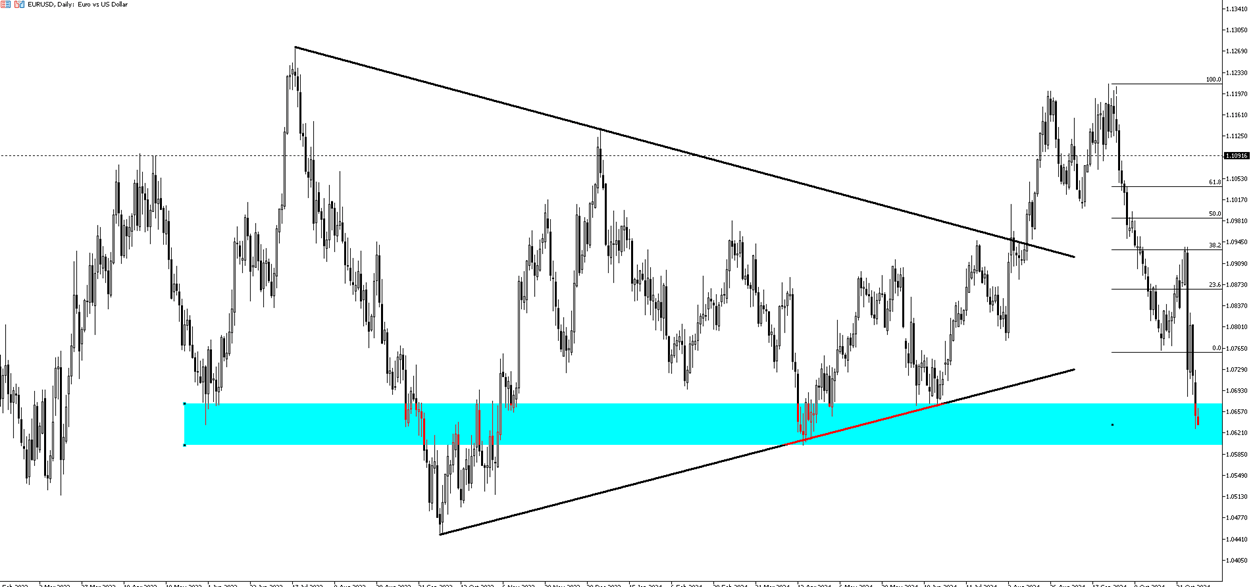
The EUR/USD pair was trading around 1.0630 on Tuesday following a sell-off the previous day, while the US Dollar Index surged above 105.6, hitting its highest level in over four months. Trump trades continued to dominate financial markets, fueled by optimism surrounding the prospects of a second Trump presidency and a potential Republican-controlled Congress. Investors are betting on deregulation and tax cuts under Trump's leadership, which could stimulate economic growth and heighten inflation pressures. This has raised expectations that the Federal Reserve may face constraints in its ability to lower interest rates. Trump's proposals to increase tariffs on major trading partners, particularly China and the European Union, alongside his plans to tighten immigration, have also added to inflationary concerns. As the week progresses, market attention is shifting toward US inflation data, which will offer more clarity on the economic outlook. Additionally, comments from Fed officials are expected to influence market expectations. The dollar's strength was evident across major currencies, with the euro and Chinese yuan both falling to multi-month lows against the greenback.
In the EUR/USD pair, the initial resistance level is at 1.0650, followed by 1.0700 and 1.0750 as subsequent resistance points. On the downside, the first support level is 1.0600. If this level is breached, the next support levels to watch will be 1.0550 and 1.0500.
| R1: 1.0650 | S1: 1.0600 |
| R2: 1.0700 | S2: 1.0550 |
| R3: 1.0750 | S3: 1.0500 |
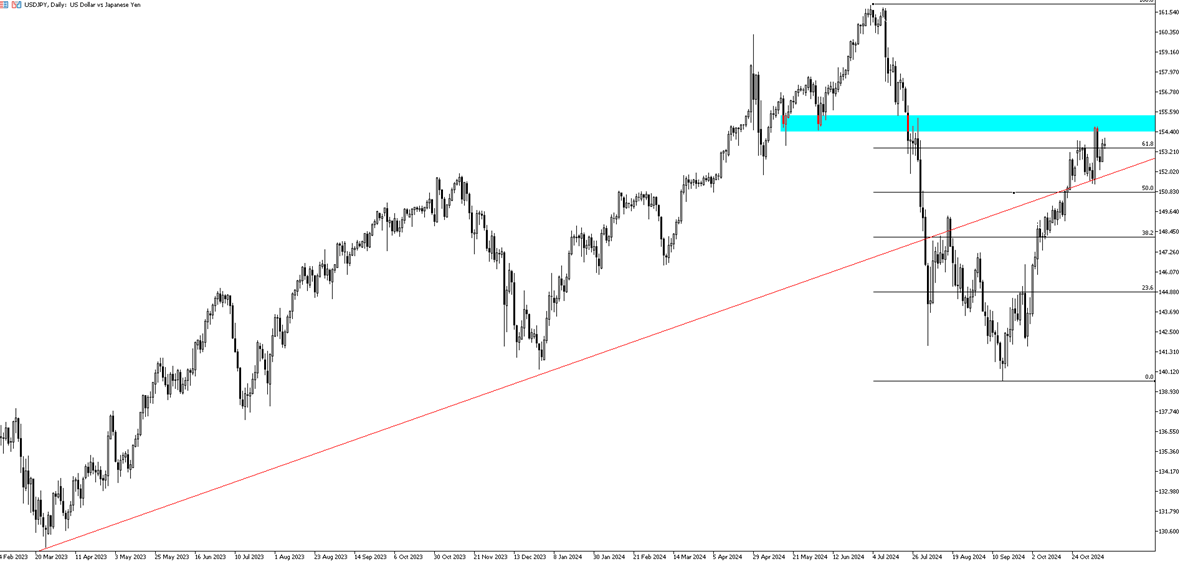
The Japanese yen remained around 153.5 per dollar, following a sharp decline in the previous session. The yen's weakness was driven by expectations of strong US economic growth and aggressive trade policies under a potential Trump presidency. Domestically, minutes from the Bank of Japan's October policy meeting revealed differences among policymakers regarding the timing of future interest rate hikes. Some members voiced concerns about global economic uncertainty and rising market volatility, especially regarding the yen's persistent depreciation. Despite these concerns, the central bank upheld its projection that it may raise its benchmark interest rate to 1% by the second half of fiscal 2025.
In the USD/JPY pair, the first support level is at 152.50, which coincides with the 200-day moving average. If this level is broken, the next support levels to monitor are 152.20 and 151.50. On the upside, resistance levels are at 154.00, 154.50, and 154.90, respectively.
| R1: 154.00 | S1: 152.50 |
| R2: 154.50 | S2: 152.20 |
| R3: 154.90 | S3: 151.50 |
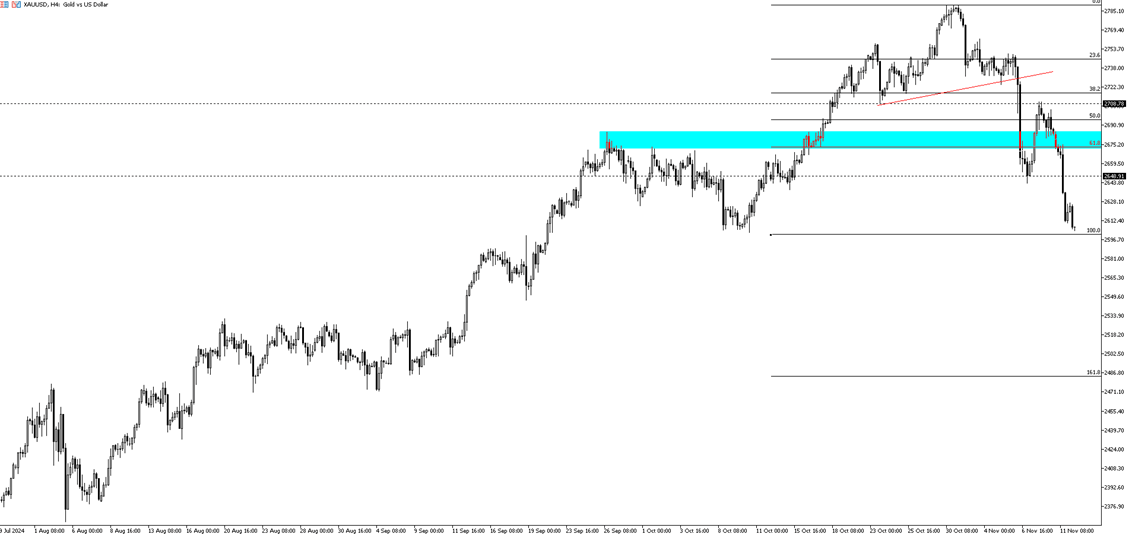
Gold prices dropped to around $2,600 per ounce, marking the third session of losses and hitting a one-month low. The decline was driven by a stronger US dollar and waning demand for safe-haven assets. Investors continued to pivot toward riskier assets as they considered the potential economic impact of Donald Trump's election victory, particularly regarding fiscal policies and monetary strategies.
The prospect of tariffs being introduced early in Trump's presidency has raised inflation concerns, which in turn has led to expectations that the Federal Reserve may delay its easing plans into next year. As a result, the likelihood of a rate cut in December has decreased, falling from nearly 80% a week ago to around 65%. On the other hand, data from the World Gold Council reveals that holdings in Indian gold ETFs have surged, doubling over the past four years to a record 54.5 tonnes as of October 31st.
On the downside, the first support level for gold is at $2,600, followed by $2,550 and $2,500. On the upside, $2,615 serves as a key resistance level, with $2,655 and $2,685 as the next levels to monitor if this resistance is surpassed.
| R1: 2615 | S1: 2600 |
| R2: 2655 | S2: 2550 |
| R3: 2685 | S3: 2500 |
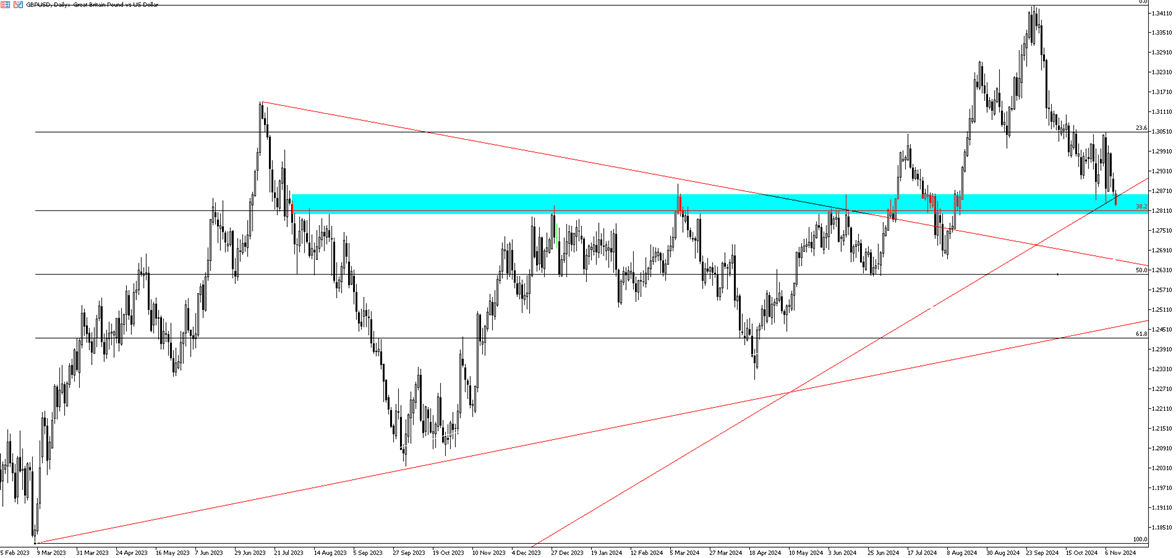
The British pound is trading around 1.2820 on Tuesday morning, marking its lowest level in nearly three months, weighed down by a stronger US dollar. Market sentiment is being shaped by expectations that Donald Trump's policies could spur inflation, potentially limiting the Federal Reserve's ability to lower interest rates. In the UK, the Bank of England implemented its second 25 basis point rate cut this year last week and adopted a cautious outlook on further cuts. Policymakers emphasized the need for a restrictive monetary policy, preferring a gradual approach to easing.
Traders are still pricing in two additional quarter-point rate cuts from the BoE by the end of next year, with just under a 50% probability of another reduction in the near term. This week, the UK is set to release a range of important economic data, including GDP growth figures for the third quarter, as well as unemployment and wage growth statistics.
On the downside, key support levels for the GBP/USD pair are at 1.2800, 1.2750, and 1.2700. Resistance levels to watch are at 1.2880, 1.2910, and 1.3000.
| R1: 1.2880 | S1: 1.2800 |
| R2: 1.2910 | S2: 1.2750 |
| R3: 1.3000 | S3: 1.2700 |
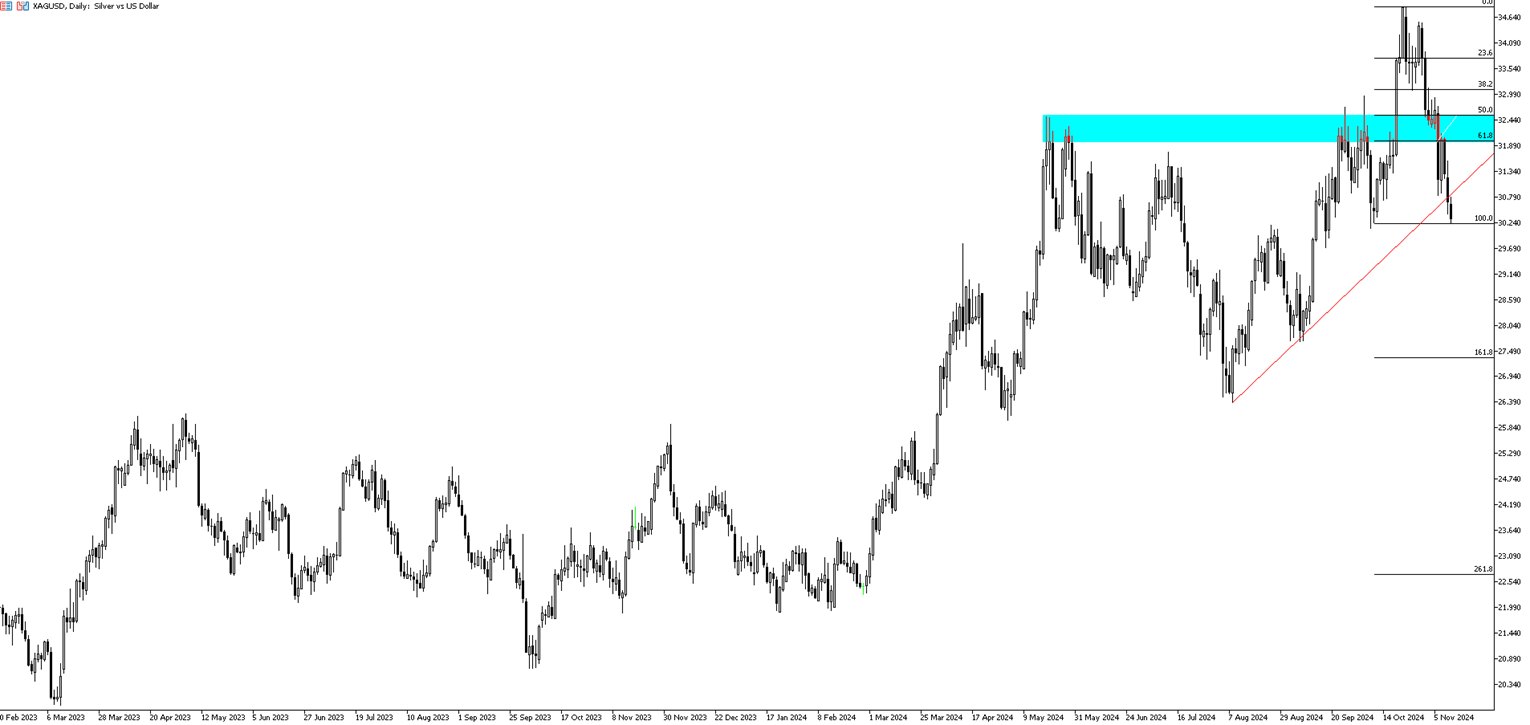
Silver is trading around $30.20, its lowest level in nearly two months, as a surge in risk sentiment dampened demand for the precious metal. This was compounded by weak fiscal support from China, the world's top consumer of silver. The prospect of expansionary fiscal policies in the US prompted investors to shift away from precious metals like silver and into riskier assets such as growth stocks and cryptocurrencies.
China chose to restructure its public debt in its latest fiscal measures instead of introducing new fiscal stimulus, diminishing previous expectations of industrial support. This decision has weighed on the outlook for industrial metals, including silver, which is heavily used in sectors like electrification and solar panels. Adding to the pressure, Chinese solar panel manufacturers have reportedly begun scaling back production, partly in response to concerns over higher tariffs on the sector that could result from Trump's election victory.
On the upside, the critical resistance levels to watch are 30.90, 31.65, and 32.00. On the downside, 29.85 remains a significant first support level. If this level is breached, the next support levels to monitor are 29.30 and 28.80, respectively.
| R1: 30.90 | S1: 29.85 |
| R2: 31.65 | S2: 29.30 |
| R3: 32.00 | S3: 28.80 |
Russia-Ukraine peace efforts remain stalled.
Detail Trump Pressures Fed as Dollar Slips After Cut (12.11.2025)The Federal Reserve ended 2025 with a 25-bps cut to 3.50-3.75%, maintaining guidance for one cut in 2026.
Detail Fed Day Takes Shape, Chair Decision Nears (12.10.2025)Income strategies are under pressure as lower yields reduce the appeal of short-term Treasuries, pushing investors toward riskier segments such as high yield, emerging-market debt, private credit, and catastrophe bonds.
DetailThen Join Our Telegram Channel and Subscribe Our Trading Signals Newsletter for Free!
Join Us On Telegram!